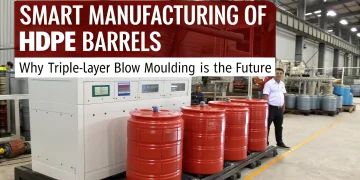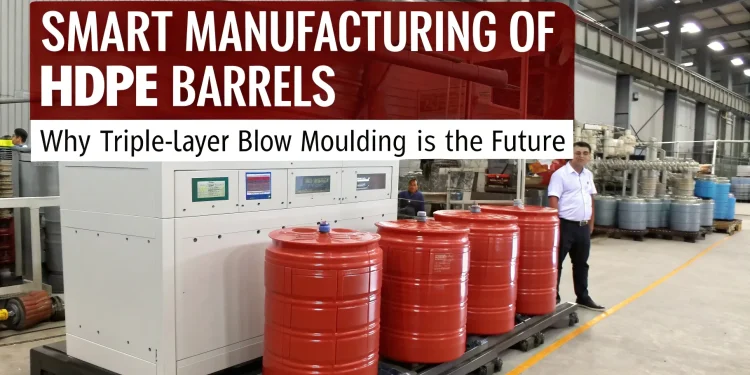From Utility to Innovation in Packaging
In today’s world, packaging serves more purposes than just creating a physical containment for the product. It helps protect the product, maintain brand image, assist in the export processes, helps with sustainability issues, and reduces costs. With rapid advancements in technology, the HDPE barrel, which is a product used for industrial storage, has undergone transformations to meet the requirements of today’s world.
The agriculture, pharmaceutical, food, and chemical industries use HDPE (High-Density Polyethylene) barrels due to their lightweight and cost effectiveness paired with their strength and resistance to chemicals. However, there is a shift towards more advanced environmentally friendly packaging which includes using triple-layer blow moulded barrels.
More companies are looking to focus on B2B packaging which is why we will be discussing the structure, growth, and potential of manufacturing triple-layer HDPE barrels in this article.
Related: HDPE Jumbo Bags Manufacturing Industry
What are HDPE Barrels? Definition, Uses, and Benefits
Definition of HDPE barrels:
An HDPE (high-density polyethylene) barrel is a stiff, cylindrical, blow-moulded product made of plastic. It is mainly used for storing liquids or powders that may face contamination, harsh weather conditions, or impacts.
Here’s why HDPE is popular:
- Strong for Weight
- Resistant to Corrosion, UV, and Solvents
- Can be Reused and Recycled
- Compliant for Food and Pharmaceutical Contact
- Is Approved for Contact with Food and Pharma grades
The most common sizes are from 30 litres to 250 litres, with 210L being standard for global transport and industrial usage.
Some Common Sector Use Cases are listed below
| Sector | Product Packed |
| Chemicals | Acids, solvents, surfactants, and catalysts |
| Pharmaceuticals | APIs, drug intermediates, and excipients |
| Agriculture | Pesticides, fertilizers, and plant growth nutrients |
| Food & Beverage | Edible oils, syrups, pickles, and various sauces |
| Paints and Inks | Oil based paints, emulsions, and mid-grade dyes |
| Petroleum & Lubricants | Industrial oils, grease and gear oils |
These barrels have become essential to supply chain efficiency—particularly for exports and other heavily regulated sectors.
Why Triple-Layer Blow Moulding Is The Next Industrial Standard
Triple-layer blow moulding is designed to address the limitations of single-layer HDPE barrels. Increasingly strict brand UV and chemical exposure, transport pressure considerations, brand-defined customization standards, and proprietary version demands escalate.
Structure of a Triple-Layer HDPE Barrel
- Inner Layer – Virgin HDPE
Ensures product purity, hygiene, and chemically inert interactions with the product.
First contact with contents. - Middle Layer – Recycled or Lightweight HDPE
Maintains structural rigidity while minimizing raw material expenditure.
Can include additives for impact absorption. - Outer Layer – HDPE With UV Protection, Branded
Offers external shielding and aesthetic finishing.
Permits brand printing, anti-static properties, or coloring.
Core Benefits of Triple Layer Barrels
- Increased Mechanical Strength: Enhanced stacking, transport, impacting, and internal pressure endurance.
- Improved Chemical Resistance: Structural integrity guarantees lower permeability, preserving contents for a longer duration.
- Sustainability: Up to 30% reduction of virgin polymer usage with the use of recycled HDPE for middle layer.
- Enhanced Branding: Screen or offset printing made easy with the smooth outer layer.
- Non-UN Certified Hazardous and Export Goods compliance.
All-in-one, triple-layer HDPE barrels fulfill all requirements under ESG (Environmental, Social, Governance) standards: performance, cost, and compliance.
Related: Starting a Chemical Packaging Plant for Drums and Carboys
Snapshot of Opportunity: Trends in The Market Value of HDPE Barrels
India’s demand in the industrial packaging value chain is rapidly shift changing. The growing exports in chemicals, processed food industries, and agro and pharma HDPE barrels, are resulting in double digit growth increases.
Key Demand Drivers:
- Metal drums substitution for HDPE barrels in chemical and petrochemical industries due to corrosion-related issues.
- Increased exports in pharma and agri, requiring leak-proof and contamination-free storage options.
- Make-in-India initiative aiming for self-sufficiency in packaging and reducing import reliance.
- Understanding sustainable packaging for brands in FMCG, pharma, and industrial sectors.
Market Insights: HDPE Barrel Industry Forecast (2025–2029)
| Year | India Domestic Demand (in Million Units) | Export Value (in Crores) | Triple-Layer Share (%) |
| 2025 | 58 | ₹1350 | 25% |
| 2026 | 66 | ₹1650 | 32% |
| 2027 | 74 | ₹1980 | 38% |
| 2028 | 82 | ₹2350 | 44% |
| 2029 | 91 | ₹2750 | 50% |
Business opportunities for exports: African, Southeast Asian, and Middle Eastern countries prefer Indian HDPE barrels because of the competitive pricing and good quality.
Trend of certification for sustainability: By 2028 over 60% of global chemical exports will need UN-certified packaging—promoting the need for triple-layer construction.
Manufacturing Process: Making Triple-Layered HDPE Barrels
Production Line Overview
In triple-layer blow moulding, the distinct method of co-extrusion blow moulding is used, where different materials are extruded into a parison and then inflated to form the barrel shape.
Key Steps in Production
- Raw Materials Charging
Virgin HDPE, recycled HDPE, and stabilizer additives have to be manually fed into separate hoppers.
Dehumidification of materials is done to avoid defects. - Extrusion and Co-Extrusion
The materials are heated in three extruders and pushed into a co-extrusion die head.
They are then combined into a parison with three bonded layers. - Blow Moulding
The parison goes into a steel mold cavity.
Air pressure completes the inflation by blowing into the parison and shaping it to form a barrel. - Cooling and Demoulding
The cooling and solidification of the barrel takes place through water channels in the mold.
The mold opens up and the formed barrel is ejected. - Trimming and Cutting
Flash at the ends of the barrel is removed.
According to the design requirements, the openings are either sealed or machined. - Testing and Inspection
The following tests are conducted on barrels to inspect them:
- Testing for leakage through air pressure or vacuum test.
- Measuring wall thickness.
- Checking stack load resistance.
- Evaluating drop impact resistance.
- Testing for leakage through air pressure or vacuum test.
- Surface Finishing Includes Printing:
Logos, instructions, hazard signs, and batch details are screen printed. - Stacking and Packaging
Barrels can be shipped in a vertical position or stacked in nesting order.
Machinery Used
- Co-extrusion blow moulding machine (triple head)
- Hopper dryers & auto loaders
- Cooling water systems and chillers
- Air compressors
- Leak testers and drop testers
- Trimming stations and screen printers
These machines can be set up in semi-automated or fully automated plants based on the desired volume.
Why Startups Should Enter The HDPE Barrel Space Now
The time is ideal for entrepreneurs because of the shift to sustainable packaging in multiple industries, and the demand for UN-certified leak-proof containers from major exporters. These factors create a perfect gap for startups to jump into HDPE barrel manufacturing.
Starting off with Strategic Advantages
Market Entry for Startups:
Target the 35L, 50L, and 120L barrels for agro and pharma industries where triple-layer packaging remains under-served.
Contract Manufacturing Prospects:
Provide production services to large multinational corporations or logistic companies seeking to subcontract.
Import Substitution:
India still imports specialty UN barrels—local production can reduce costs and duties.
Eco Branding and Customization:
Customize branding with the use of recycled content branding, anti-static layers, or solar resistant polymers.
B2B Sales Channels:
Focus on agrochemical companies, edible oil manufacturers, chemical industry processors, and logistics companies.
The HDPE barrel units have a low cost of operations and great potential for scale. With some automation and reduced employee demands, these units are a great investment.
Concerns and Legal Considerations
While the sector looks profitable, startups need to think about some concerns:
- Legal Red Tape: Mandatory pollution control boards, factories licensing, dealing with hazardous chemicals, chemical factory exposure handling, and norm compliance.
- Dealing with Waste: Generates and manages excess texture. Also manages excess mold parts, scraps, and internal recycling within state guidelines.
- Sky-HI MFI: Managing high releasable microstructure HDPE from trusted sellers greatly affects product quality.
- Protecting UN Certification: For barrels meant to be exported undergoes drop neck and leak tests to qualify “UN certified”.
Effective governance in those areas allow the company to fiercely battle emerging rivals and focus its resources with the right partners.
How NPCS Supports New Entrepreneurs in HDPE Barrel Manufacturing
To navigate the technical and regulatory landscape, many first-time manufacturers rely on expert industrial consultants.
NIIR Project Consultancy Services (NPCS) is a leading firm that supports startups in evaluating and launching industrial projects.
NPCS Helps You By:
- Preparing Market Survey cum Techno-Economic Feasibility Reports on HDPE barrel projects.
- Providing end-to-end manufacturing details: raw materials, machinery, workflow, utilities, and layout plans.
- Helping you assess the technical and financial feasibility before investment.
For entrepreneurs serious about entering smart, scalable industrial businesses, NPCS acts as a technical compass and execution guide.
For more information check our Project Reports
Conclusion: A Barrel of Opportunity for India’s Industrial Entrepreneurs
As packaging standards rise across industries and sustainability becomes a purchasing factor, the demand for triple-layer HDPE barrels is only going to grow.
Entrepreneurs entering now can position themselves as solution providers—offering safe, sustainable, and regulation-compliant containers to industries that need them the most. With the right technology, process optimization, and market positioning, HDPE barrel manufacturing isn’t just an industrial activity—it’s a long-term business opportunity with global relevance.
And with strategic planning support from NIIR Project Consultancy Services, your transition from idea to implementation can be smoother, smarter, and successful.


















